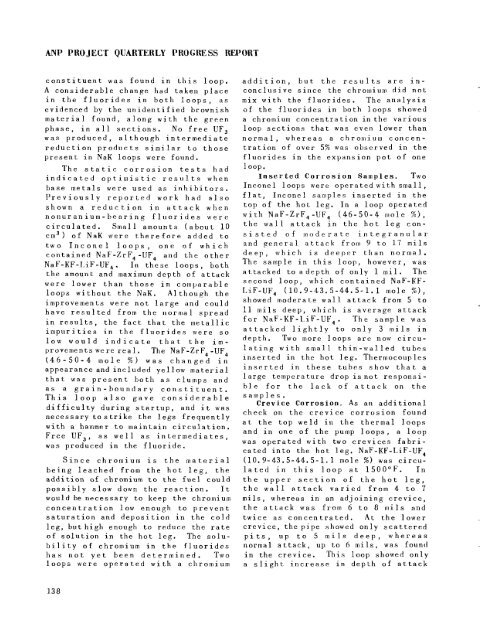the Molten Salt Energy Technologies Web Site
the Molten Salt Energy Technologies Web Site
the Molten Salt Energy Technologies Web Site
Create successful ePaper yourself
Turn your PDF publications into a flip-book with our unique Google optimized e-Paper software.
constituent was found in this loop.<br />
A considerable change had taken place<br />
in <strong>the</strong> fluorides in both loops, as<br />
evidenced by <strong>the</strong> unidentified brownish<br />
material found, along with <strong>the</strong> green<br />
phase, in all sections. No free UF,<br />
was produced, a1 though intermediate<br />
reduction products similar to those<br />
present in NaK loops were found.<br />
The static corrosion tests had<br />
indicated optimistic results when<br />
base metals were used as inhibitors.<br />
Previously reported work had also<br />
shown a reduction in attack when<br />
nonuranium-hearing fluorides viere<br />
circulated. Small amounts (about 10<br />
cm3) of NaK were <strong>the</strong>refore added to<br />
two Inconel loops, one of which<br />
contained NaI;'-ZrF4 -UF, and <strong>the</strong> o<strong>the</strong>r<br />
NaF-KF-LiF-UF4. In <strong>the</strong>se loops, both<br />
<strong>the</strong> amount and maximum depth of attack<br />
were lower than those in comparable<br />
loops without, <strong>the</strong> NaK. Although <strong>the</strong><br />
improvements were not large and could<br />
have resulted from <strong>the</strong> normal spread<br />
in results, <strong>the</strong> fact that <strong>the</strong> metallic<br />
impurities in <strong>the</strong> fluorides were so<br />
low would indicate that <strong>the</strong> i m -<br />
provements were real. The NaF-ZrF4-UF4<br />
(44-50-4 mole %) was changed in<br />
appearance and included yellow material<br />
that was present both as clumps and<br />
as a grain-boundary constituent.<br />
This loop also gave considerable<br />
difficulty during startup, and it was<br />
necessary to strike <strong>the</strong> legs frequently<br />
with a hammer to maintain circulation.<br />
Free UF,, as well as intermediates,<br />
was produced in <strong>the</strong> fluoride.<br />
Since chromium is <strong>the</strong> material<br />
being leached from <strong>the</strong> hot leg, <strong>the</strong><br />
addition of chromium to <strong>the</strong> fuel could<br />
possibly slow down <strong>the</strong> reaction. It<br />
would be necessary to keep <strong>the</strong> chromium<br />
concentration low enough to prevent<br />
saturation and deposition in <strong>the</strong> cold<br />
leg, but high enough to reduce <strong>the</strong> rate<br />
of solution in <strong>the</strong> hot leg. The solu-<br />
bility of chromium in <strong>the</strong> fluorides<br />
has not yet been determined. Two<br />
loops were operated with a chromium<br />
138<br />
addition, but <strong>the</strong> results are inconclusive<br />
since <strong>the</strong> chroinium did not<br />
mix with <strong>the</strong> fluorides. The analysis<br />
of <strong>the</strong> fluorides in both loops showed<br />
a chromium concentration in <strong>the</strong> various<br />
loop sections that was even lower than<br />
normal, whereas a chromiuin concentration<br />
of over 5% was observed in <strong>the</strong><br />
fluorides in <strong>the</strong> expansion pot of one<br />
1 oop.<br />
Inserted Corrosion samples. Two<br />
Inconel loops were operatedwith small,<br />
flat, Inconel samples inserted in <strong>the</strong><br />
top of <strong>the</strong> hot leg. In a loop operated<br />
with NaF-ZrF4-UF, (46-50-4 rirole %>,<br />
<strong>the</strong> wall attack in <strong>the</strong> hot leg con-<br />
sisted of moderate integranular<br />
and general attack from 9 to 17 m i l s<br />
deep, which is deeper than normal.<br />
The sample in this loop, however, was<br />
attacked to adepth of only 1 mil. The<br />
second loop, which contained NaF-KF-<br />
LiF-UF, (10.9-43.5-44.5-1.1 mole %),<br />
showed moderat,e wall attack from 5 to<br />
11 m i l s deep, which is average attack<br />
for NaF-KF-I,iF-UF4. The sample was<br />
attacked lightly to only 3 m i l s in<br />
depth. Two more loops are now circu-<br />
lating with small thin-walled tubes<br />
inserted in <strong>the</strong> hot leg. Thermocouples<br />
inserted in <strong>the</strong>se tubes show that a<br />
large temperature drop is not responsi-<br />
ble for <strong>the</strong> lack of attack on <strong>the</strong><br />
sainples.<br />
Crevice Corrosion. As an additional<br />
check on <strong>the</strong> crevice corrosion found<br />
at <strong>the</strong> top weld in <strong>the</strong> <strong>the</strong>rmal loops<br />
and in one of <strong>the</strong> pump loops, a loop<br />
was operated with two crevices fabri-<br />
cated into <strong>the</strong> hot leg. NaF-KF-LiF-UF4<br />
(10.9-43.5-44.5-1.1 mole %) was circu-<br />
lated in this loop at 1500°F. In<br />
<strong>the</strong> upper section of <strong>the</strong> hot leg,<br />
<strong>the</strong> w a l l attack varied from 4 to 7<br />
mils, whereas in an adjoining crevice,<br />
<strong>the</strong> attack was from 6 to 8 mils and<br />
twice as concentrated. At <strong>the</strong> lower<br />
crevice, <strong>the</strong> pipe showed only scattered<br />
pits, up to 5 m i l s deep, whereas<br />
normal attack, up to 6 mils, was found<br />
in <strong>the</strong> crevice. This loop showed only<br />
a slight increase in depth of attack



![Review of Molten Salt Reactor Physics Calculations [Disc 2]](https://img.yumpu.com/21979492/1/190x247/review-of-molten-salt-reactor-physics-calculations-disc-2.jpg?quality=85)












